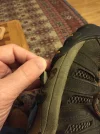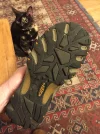This is a tad long, but necessary I think. The correct answer is... "it depends..." the reasons are thus:
1. Everyone walks on this earth differently. No two feet are aligned the same, even on the same body. I have one foot (left) that points directly straight ahead and has a "normal" foot at the end of it. This left foot is relatively straight, flat, and has normal arch, instep, ball and heel.
My other leg & foot points out from the centerline of travel at a 5 degree angle, and the foot at the end of this wayward stump is canted out and up at another 3 degree angle at the heel. The result is that I get calluses on my right foot that would stump a farrier (the fellow the shoes horses hoofs). AS I get older, this odd geometry also does wonders (NOT) for my knees and hips.)

Since my first & near-last Camino in 2013, I now get regular monthly pedicures, and just had my pre-Camino pedicure 2 days ago. The young lady has to use a kitchen rasp - the device one uses to remove 'zest' from citrus fruit for baking, etc. It functions for food and feet the way a rougher rasp works in the mechanic or carpenter's shop for shaping wood or metal. THAT is why I make the farrier reference. It is true. We joke about it. The young lady usually says "good morning horsey man..."

These are the parts I was assigned at birth. I have no medical condition or prior injury causing it.
2. If you read above, you understand that no one wears any pair of footwear the same. Even one person (like me) can have a pair of shoes, each of which wears differently.
3. Even if all things are "normal and perfect," the terrain and surface you walk on causes more or less wear on your footwear. Friction = abrasion. Abrasion results in loss of sole and heel material. More abrasion means more wear and less distance.
4. Beyond #1 and #3 above, if you weigh more, or carry more, the net abrasion increases. Thus, you increase wear.
5. Every person has a different gait and step. That means the geometry with which each step hits and recovers from whatever surface you are walking on.
Some people walk from the heel to the balls of their feet in a more or less rocking motion. This is considered a normal step. Some folks walk primarily on the balls of their feet. Others "pronate" or have feet that tend to roll out or inwards as they take each step. This is among the range of "normal" feet." Then you have folks with specific geometric / architectural (non-disease) issues. Things like flat arches, high insteps, chronic corns, bunions, calluses, bone spurs, etc. The result is that one hundred people all walking the same route can have two hundred different "foot prints."
Also, some folks pick their feet up when they walk, and others literally scrape their heels along. This adds to the abrasion issue discussed above.
6. Every manufacturer uses different tread patterns, and material compounds for their heels and boots. Some are intended for smooth surfaces, and others for hard rocky surfaces. Most hiking boots have to be designed for mixed surface use. A boot designed for off-road through hiking will not stand up as well to the constant abrasion of paved surface and road walking, as is found on most the Camino routes.
So, when considering any footwear for the Camino, try to find out what the intended use of that footwear was, from the manufacturer, not the shop clerk. You need to do your research. It is no different than buying a new car. The type of tires DO make a difference in the intended use, handling and fuel mileage. The same paradigm holds in this discussion.
So, when I said "it depends" I meant it. Getting back to the original question, I too wear Keens.
My preferred "weapon" is the Keen Targhee mid-high hiking boot. I am on my second pair. The first pair did four full Caminos before I retired them...with being resoled.
The first outsole / heel only lasted about 1,000 km, 600 - 700 miles (+/-) before I sent them out for resoling. This was accomplished with training walks pre-Camino in 2013, then the full
Camino Frances from SJPdP twice, Camino Portugues from Porto, and the Camino Madrid from Madrid.
Yes, these Caminos add up to more than 1,000 km, closer to 3,000 actually. The fact is that when I finished my first Camino in 2013, after maybe 1,000 km total - training (200 km) and the Camino (800 km), the mid-lining of the heels were popping through.
I wrote to Keen to complain. Also, I enclosed photos with my e-mail. Within several days of receiving my e-mail, they issued me a credit for a FREE pair of replacement boots from their website. So, I ordered the exact same boots because I really like them a lot, and still do. THEN I sent the original boots out for resoling as discussed here. IIRC the whole experience with resoliing by mail cost about USD 85. This might seem expensive, but consider that these boots were already well broken in, and ready to go...
Most folks do not know it but if you Google or Bing "hiking boot resoling" you can find someone to help you. Even if their web site does not list your specific shoe or boot, contact them and ASK. I did, and found a shop that offered mail service, both ways and resoled my Keens, TWICE, with factory supplied "findings" (parts). They used the same vulcanizing process to adhere the new bottoms to the shoe upper. The boots, when returned appeared new to me. They had new outsoles / heels, and new sock liner, and new laces (if needed).
So, my first pair of Keens had three soles (original + two resoles) and did four Caminos. After the fourth, the uppers were starting to show wear. So into the local donation box they went and out came the Keen-provided NEW preplacement.
To answer the original question: "How long should my hiking boots last?", the original answer pertains, it depends...
Hope this helps.

 c
c
 c
c





















